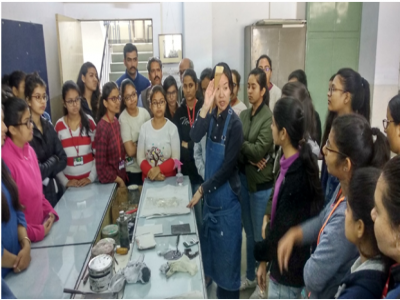Japanese Wood Block Print Making Workshop By Kenji Najima and Tomoyo Ihaya

“Japanese Woodblock Printmaking by Kenji Najima” And “Demonstration cum artist talk on Chine- Colle by Tomoyo Ihaya”
The Department of Visual Arts organized a three day workshop on “Japanese Woodblock Printmaking by Kenji Najima” and “Demonstration cum artist talk on Chine- Colle by Tomoyo Ihaya”. The workshop was from 25 -27 February, 2019 from 10 am to 4 pm Visual Arts Department of IIS University Campus, Mansarovar, Jaipur. Kenji Najima and Tomoyo Ihaya were the artists invited from Japan for their demonstration. Born in 1968 at Mie, Kenji Najima is a Japanese Printmaker who completed his Bachelors of Art in Japanese Literature from Chukyo University. He has held many solo and group shows Internationally in countries like Thailand and Taiwan in 2017, U.S.A in 2015, Scotland in 2005, Hungary in 1999 the last one being at Mie Gallery, Japan in 2018. His work has been appreciated and has featured on the book covers of many Japanese writers. His works are in the collection many Japanese Museums like the Fukuoka Art Museum, Kurbo City Art Gallery, The Museum of Modern Art Wakayama and others. Kenji Najima states that “There is always and underlying sense of silence and sorrow in my work. Like Wabi-Sabi sentiment, a world view on the acceptance of imperfection, it is naturally expressed or it is intentional in the creative process. A voice is not necessarily heard when it is loud. Sorrow is not always somberness and it can be about compassion and beauty.” Kenji Najima works on woodblock plates and prints them with a baren, a hand tool with flat bottom used in Japanese woodblock printmaking on handmade Japanese paper using watercolor pigments.
In this workshop, Japanese artist Kenji Najima displayed his prints, discussed his works’ subject, technique and process and demonstrated how to create water based wood block print. Students of department and faculties participated in this workshop and interacted with the artist who generously elaborated his technique to the students.
The printmaking studio of Visual Arts Department of IIS University Campus, Mansarovar, Jaipur on 27th February 2019 was bustling with young artists on Wednesday when Canada-based Japanese artist Tomoyo Ihaya shared with them a special technique of graphic art in the morning. The printmaker demonstrated techniques of Chine Colle graphic art. The usual intaglio style of printmaking involves the incision of the required image on a metal plate on which ink is applied and then imprinted on a thick paper. In the Chine Colle method, the paper used is of a smoother and thinner variety. The artist does not need to prepare and print additional plates. “This is an Italian technique in which the image produced is creamier and has special effects of smoother textures. Since initially Chinese natural fibre paper was used, the method is known as Chine Colle. But now, a Japanese paper, gampi, made from a variety of wild mulberry plants, is used,” said Tomoyo. She demonstrated how the same image when produced on gampi has sharper details than on European paper. Students also tried their hand at it and Tomoyo guided them well. It was an exceptional experience for the students.
Tomoyo shared her drawing and painting concepts during a deliberation on the same day in evening at the same venue. Brought up in Tsu, a small city in Japan, she is a graduate in German literature from Rikkyo University in Tokyo. Printmaking and etching are her forte, for which she is acclaimed worldwide. Her recent works were based on her visit to Ladakh. In her talk, Tomoyo shared her experiences of encountering the Tibetan community in exile in India experiencing painful news of their people self-immolating in fire one after another in China-occupied Tibet. She put on show her experiences in the past visits in India through her drawings (drawing a cremation site in Varanasi, documenting fire pits, cremation alters, and contemplating on life and death around fire) synchronized with this particular movement, an extreme way of ‘offering’ their bodies to ‘fire’ for asking freedom and peace. She said that ‘I could not help drawing large and small as emotional response and with a sense of mourning. After coming back to Vancouver, the self-immolation kept happening and I felt that my personal and professional task is not finished’. Through her travels, she’s been sensitized to cultural upheaval and disadvantaged peoples. Much of her art speaks to deprivation, oppression, lost homelands, escapes and exile. She has developed her own iconography to convey compassion for this misery. Frequent symbols are legs – often truncated at the knee – eyes, fires, tear drops and empty bowls. At times, she even burns small holes in her paper with incense sticks. Her latest exhibition, Eyes Water Fire, at Art Beatus in Vancouver until Nov. 25, is another paean to compassion. Delicately drawn icons, sometimes painted in gentle tones, elicit a visceral response. Blue legs, for instance, “cross the borders on snow-covered mountains or swim across the ocean,” says Ihaya. Or flames awash in red declare “resistance and dignity or lights of prayers.” Ihaya has taken her work to new heights in this show, incorporating her lyrical drawings and mixed-media pieces into complex videos and installations. The video work is particularly striking as it animates her symbolic language and enlivens it with the use of minimalist audio such as rushing water, the whoosh of wind across barren terrain and bare feet shuffling along the ground.

